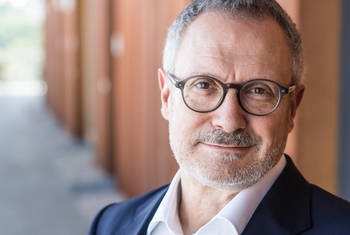Michael Petraglia What New Insights Can Archeology Provide Into Homo sapiens’ Emergence from Africa?
Michael Petraglia is Professor of Human Evolution and Prehistory at the Max Planck Institute for the Science of Human History. Formerly a Lecturer in Cambridge’s Faculty of Archaeology and a Professor in Oxford’s School of Archaeology and Anthropology, he has been involved with the Human Origins Program at the Smithsonian Institution in Washington D.C. since its inception. Working primarily on the Arabian Peninsula and the Indian subcontinent, Petraglia’s main research interests include human evolution and the links between ancient out of Africa migration and climate change. Author and editor of numerous scholarly works, Pertaglia’s most recent edited collection (with Nicole Boivin and Rémy Crassard) is entitled Human Dispersal and Species Movement (2017).
Area of Research
Anthropology, Human Origins, Human Evolution & History, Archeology
since 2016
2009-2016
Professor & Co-Director
University of Oxford
Centre for Asian Archaeology, Art and Culture
2001-2009
Lecturer
University of Cambridge
Faculty of Archaeology and Anthropology
since 1988
Postdoc Fellowhip
Smithsonian Institute
since 1987
PhD
The University of New Mexico
 © Maximilian Dörrbecker
© Maximilian Dörrbecker
Max Planck Society
"The Max Planck Society is Germany's most successful research organization. Since its establishment in 1948, no fewer than 18 Nobel laureates have emerged from the ranks of its scientists, putting it on a par with the best and most prestigious research institutions worldwide. The more than 15,000 publications each year in internationally renowned scientific journals are proof of the outstanding research work conducted at Max Planck Institutes – and many of those articles are among the most-cited publications in the relevant field." (Source)
Institute
Max Planck Institute for the Science of Human History
The Max Planck Institute for the Science of Human History conducts basic research using modern analytical methods with the aim of a multidisciplinary and integrated science of human history. It seeks to bridge the gap between historical disciplines and the natural sciences. Scientists from a range of fields, such as biology, linguistics, archaeology, anthropology and history jointly work on innovative methods, in particular in the fields of cutting-edge genetic and proteomic sequencing, bioinformatics, archaeological science, computational modeling, language databases, and phylogeography. This thoroughly integrated, interdisciplinary approach will address long-standing questions about human history – including some previously deemed difficult, or even completely intractable – as well as novel questions inspired by the new horizons that cutting edge methods open up. (Source)
Map
Traditional theory holds that Homo sapiens’ first moved Out of Africa into Eurasia along coastal routes some 60,000 years ago. In this video, MICHAEL PETRAGLIA explodes this theory demonstrating that modern humans emerged from Africa much earlier and, at least some of the time, via inland routes. Employing satellite imagery to identify ancient rivers and lakes in what are present-day desert regions, the team pinpointed adjacent archaeological and paleontological sites which were then precisely dated. Not only does the work present evidence that Homo sapiens was already moving Out of Africa some 200,000 years ago, it also shows that these migrations occasionally happened inland. Along with giving us a deeper understanding of the history and abilities of our ancestors, positing a link between ancient Out of Africa migration and episodes of climate change, Petraglia’s research also has fascinating relevance to contemporary debates.
LT Video Publication DOI: https://doi.org/10.21036/LTPUB10702
Rethinking the Dispersal of Homo sapiens out of Africa
- Huw S. Groucutt, Michael D. Petraglia, Geoff Bailey, Eleanor ML. Scerri, Ash Parton, Laine Clark-Balzan, Richard P. Jennings, Laura Lewis, James Blinkhorn and Nick A. Drake
- Evolutionary Anthropology: Issues, News, and Reviews
- Published in 2015







